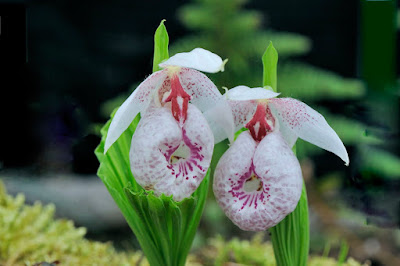Cypripedium formosanum is endemic to Taiwan. It occur in a variety of habitats from montane forest, thickets, cool temperate mountains and open, damp places and grows in the undergrowth at an altitude of 2000-3000 meters...
Cypripedium formosanum also called as The Beautiful Cypripedium, Formosa's Lady's Slipper, Cypripedium japonicum var. formosanum, is a species of the genus Cypripedium. This species was described by Bunzo Hayata in 1916.
IDENTIFY CYPRIPEDIUM FORMOSANUM
Cypripedium formosanum is endemic to Taiwan. It occur in a variety of habitats from montane forest, thickets, cool temperate mountains and open, damp places and grows in the undergrowth at an altitude of 2000-3000 meters. Now it is very rare in nature due to heavy harvesting, but fortunately it is quite common in cultivation.
The Beautiful Cypripedium is a small sized, cold growing terrestrial with a stem carrying 2, apical, ovate to round, plicate leaves with the veins radiating out like a fan.
Formosa's Lady's Slipper blooms with a terminal, slender, 10 cm long, single flowered inflorescence occuring in the spring. The flowers are 6-7 cm in diameter.
CYPRIPEDIUM FORMOSANUM CARE AND CULTURE
Cultural information should only be used as a guide, and should be to be adapted to suit you. Your physical location; where you grow your plants, how much time you have to devote to their care, and many other factors, will need to be taken into account. Only then can you decide on the cultural methods that best suit you and your plants.
Light:
Cypripedium formosanum needs a light level between 14000 and 18000 lux. To feel good, the plant does not require direct sun and can also develop in the shade. It is always better, however, if it is the bright shadow, an example of which would be a corner where the sun does not reach the sunny terrace.
Temperature:
In the summer the average temperature is 22-24 ° C during the day and 16-18 ° C at night. However, it can also withstand higher temperatures ( 30 ° C at most), but everything must be done to keep the substrate as fresh as possible.
Humidity:
If the air humidity falls below 40%, The Beautiful Cypripedium reacts by drying the tips of the leaves. Therefore, it is advisable to keep the humidity of air around the orchid above 45-50%.
Substrate, growing media and repotting:
Cypripedium formosanum is cultivated only in pot, because it is a terrestrial species. As a substrate I used the mixture of peat from the industrial soil for orchids with perlite and vermiculite in proportion 1: 2: 1. The upper layer (only the last 2 cm) consists of pure perlite, so the earth does not touch the green stems and does not cause rottenness. On the bottom of the vase you put the lava stone to drain. Only the terracotta ones are used as a vase: they allow perspiration, which is essential during the hot days to lower the temperature of the substrate. This orchid does not like to have roots in the heat, even if it is more resistant to the heat of many other Cypripedium. Another consideration about the vase is that it is better to choose one wide, because this species multiplies and expands rapidly. The best shape of the vase would be a bowl with a minimum diameter of 45 cm, and a minimum depth of 25-30 cm. It is also possible to grow it in the narrower pots, but it will be necessary to either decant it or divide it every 1-2 years. This species is absolutely open, in home suffocates and suffers. It is placed in a well-ventilated place, cool, quite bright but without direct sun (even if the morning sun on days not too hot is acceptable).
Watering:
During the growth (from March to November), the orchid is water regularly and abundantly, the substratum must always be well moist, but woe if there are stagnant water in the saucer: the root rot will be unavoidable. When the leaves begin to dry, the watering is reduced, but the substrate is kept wet, however, and during the resting phase.
Fertilizer:
This orchid is only fertilized during growth. Fertilizers are welcome, use 1/4 of the dose indicated on the bottle of a special liquid fertilizer for orchids every week. Once a month the substrate is rinsed: the vase is placed under running water for 2-3 minutes to wash away the accumulation of mineral salts that could burn the roots. From October to March / April fertilizations are suspended.
Rest period:
Cypripedium formosanum spends the winter in its vase; the substrate is kept moist but not soggy. Winter temperatures must stay within 3-10 ° C and never fall below zero. In this period there is no need of light, because the plant is completely at rest and is not vegetating. The pot can therefore easily be placed in a fresh cellar and brought back to the balcony / terrace from mid-February / beginning of March (depending on the area), when night temperatures definitely exceed 5 ° C. In areas where nighttime temperatures never drop below zero, the pot can be left in its summer position without problems.















COMMENTS